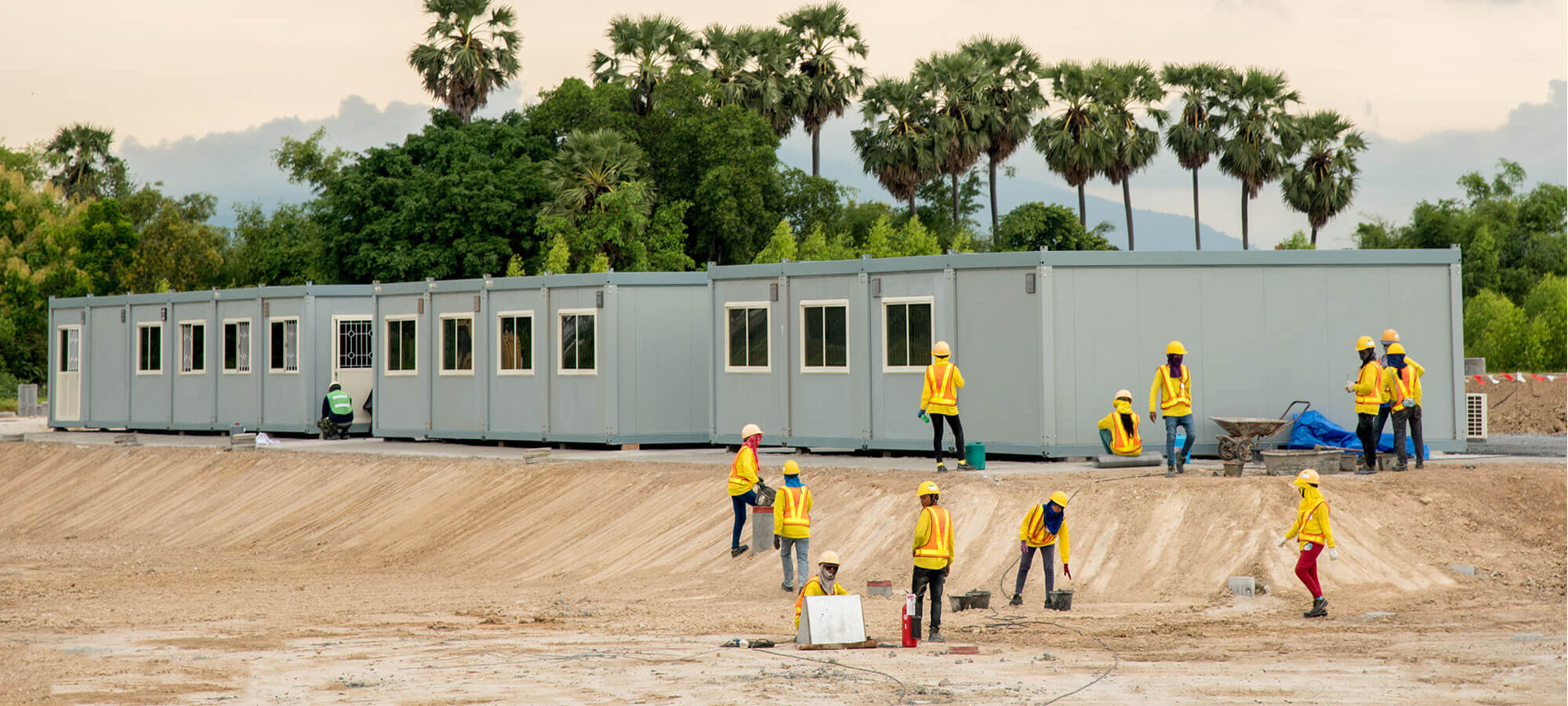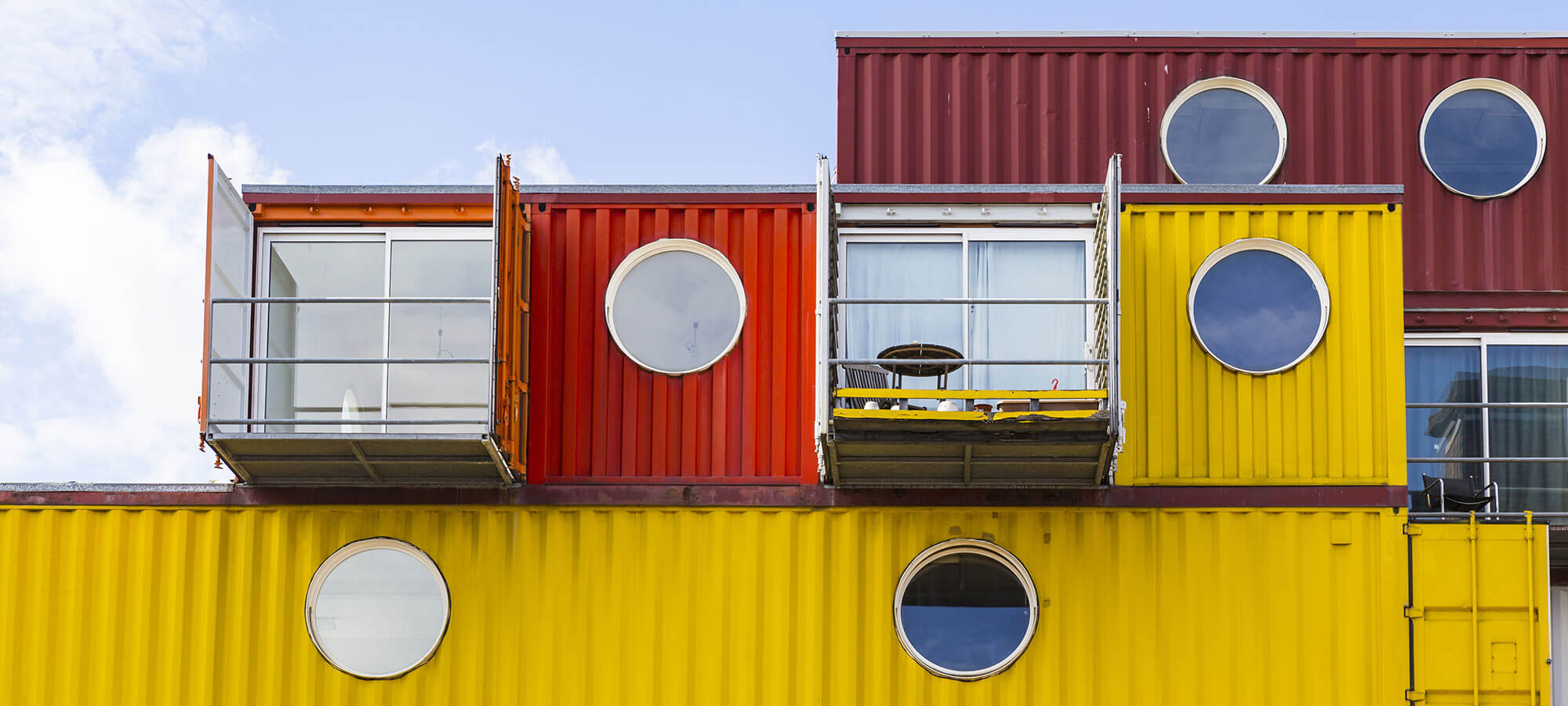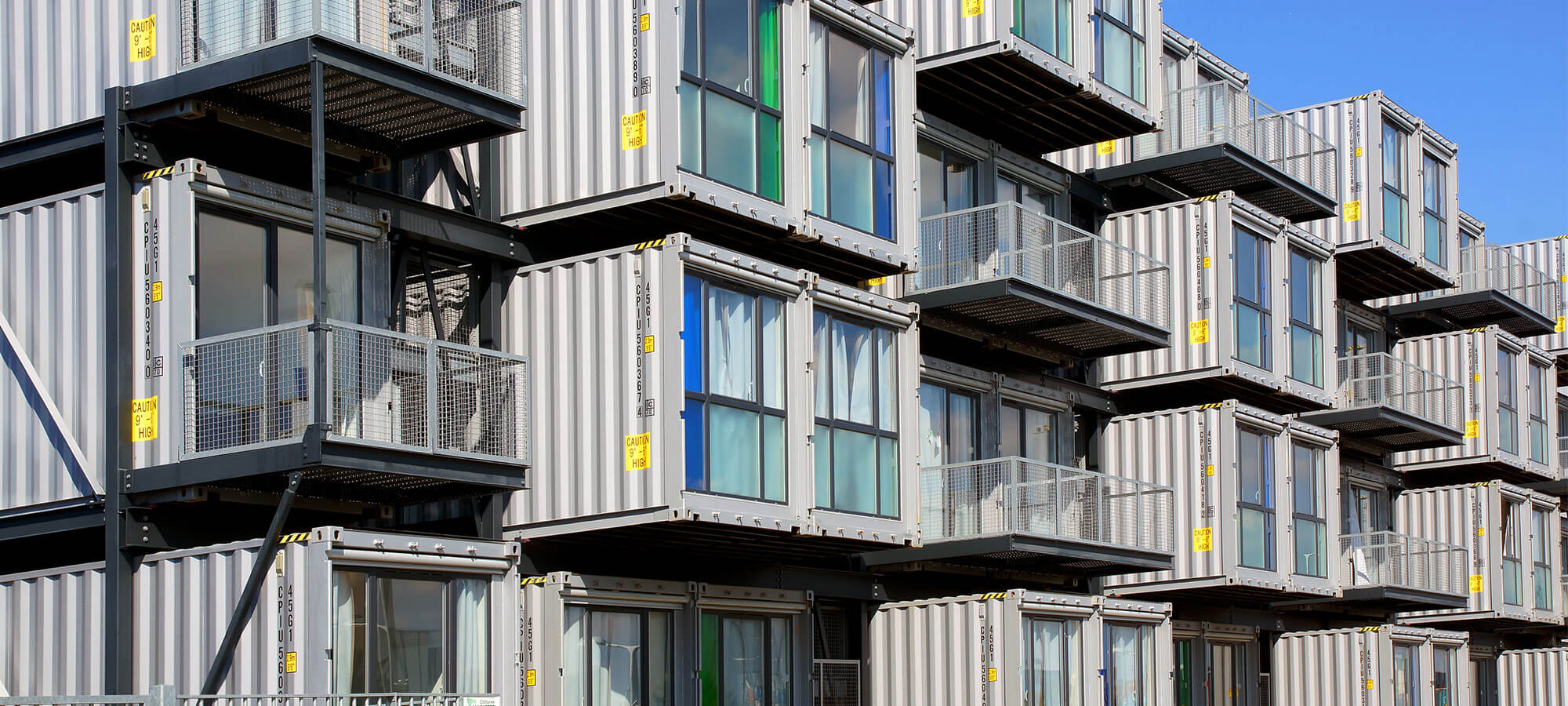Homelessness is not a new phenomenon in South Africa. It probably dates from the industrial revolution when mines opened up all over Africa, and single males flocked to find work. Hence it pre-existed the apartheid era and continued throughout it leaving a legacy of human misery.
Commerce did not create this situation deliberately. However, there are things commerce could do towards a truly South African low cost housing solution. We believe re-deploying used shipping containers to destitute areas is well-worth considering. These would become permanent housing in our minds, with suburbs of container homes popping up all over the country.
It’s also possible they could be stop-gap solutions in temporary settlements while permanent homes were constructed on more suitable ground. Then the containers could move on to the next site.
There is no national consensus on how many people are homeless, and only a guestimate how many live in informal ‘squatter camps’. The problem has become so immense most South African metro’s view it primarily as a social dependency issue and respond with social interventions they can afford. However, if we were to ask the homeless people what they need, they would likely respond ‘employment and well-located affordable housing’. Redeploying used shipping containers as houses would help address both these needs. We say so because this would spawn a cottage industry of people fitting them out.

The government came to power with a raft of promises hoping to heal all social ills. It soon discovered it inherited a large – and growing – urban housing backlog with scarce urban space to accommodate it.
It also discovered the private sector was ill-prepared to help address this. The financial sector was not geared to lending money to homeless people, and in any case few of them could afford to service loans, even if they obtained them.
Nonetheless, the Nelson Mandela Foundation recalls the new government ambitiously promised a million new homes. Their South African low cost housing solution envisaged capital subsidies covering the cost of small houses with basic services. It is interesting that container homes were never seemingly considered as a viable and efficient solution.
It also envisaged financial institutions granting loans for more elaborate homes. However for a variety of reasons this initiative failed to achieve its promises. Accordingly the government created a National Housing Finance Corporation to help mitigate risk while providing working capital guarantees for small contractors.
A visit to any tribal area, urban location, or informal housing settlement provides compelling proof we are a nation of homeowners. The Nelson Mandela Foundation believes 80% of South Africans live in their own homes, although the definition of ‘ownership’ varies.
The remaining 20% - excluding the truly homeless – live mostly in backyard / informal rentals on the fringes of cities. However some are moving into small apartments in inner-city areas.
Many continue to live in hope the government will allocate them a starter brick-and-mortar house. However the reality is gradually dawning on South Africa that we need a faster way to get people under water-proof roofs.
We believe used shipping containers have an important role to play in an achievable South African low cost housing solution. We say so because shipping container homes are affordable and quick and easy to erect.
South Africa’s constitution protects everyone’s right to access adequate housing. However, in November 2018 IOL News confirmed a landmark 2000 Court ruling was still outstanding. This stipulated “the most vulnerable people – those living in extreme conditions of poverty, homelessness or intolerable housing – should be given priority access to housing”.
However, 25 years later we still have some 3.3 million people living in informal settlements. This is likely because municipalities don’t have realistic deadlines or the cost is too enormous for them to afford.
Homeownership therefore remains an elusive, perhaps unachievable goal for millions of South Africans despite best efforts by bankers and developers. Suitable urban land is becoming more expensive. The economy is hardly encouraging lenders to take risks.
South Africa therefore appears to have reached the point where it needs to realistically reconsider the dream of ‘from sticks-and-plastic to brick-and-and-mortar in one easy step’.
We are still committed to that noble end goal. However, we have reached the conclusion the South African low cost housing solution is more complex than we imagined, because of the magnitude of the task ahead.
It takes a while for a national census to arrive on our computer screens. However, we do know that “slightly over four-fifths (80.1%) of South African households lived in formal dwellings in 2017” according to Stats SA.
Their 2018 General Household Survey reported 16.2 million households with a surprisingly low average 3.7 members each. Of the remaining 19.9%, 13.6% were in informal dwellings, and 5.5% lived in traditional dwellings. The rest were unaccounted for and probably homeless.
Crunching these numbers suggest the backlog for decent housing is actually 2.3 million households, or 8.5 million people. Of these:
To us, it seems abundantly clear this is at least a 20-year job, whichever set of numbers is more correct. However, social pressures and a burgeoning population will not tolerate this situation much longer.
We need a stop gap and we believe shipping container homes have an important role to play in a practical South African low cost housing solution, although we acknowledge this is not an ideal situation we would otherwise have supported at first thought.

South Africa has one of the world’s most ambitious housing policies. It has delivered 3 million publicly-funded houses since 1994 and that’s a proud record for a developing country. However Stats SA’s General Household Survey reveals we are losing traction in metropolitan areas.
Only 21% of eThekwini (Durban) residential properties are government subsidized according to Housing Finance Africa. That’s the smallest share of any South African metro. The municipality has an ambitious plan to eradicate the housing backlog in 40 years by purchasing 700 parcels of land and handing them to disadvantaged people.
The plan envisages residents building their own homes, instead of waiting for low cost housing. An Urban Settlements Development Grant will fund the purchase. However their ambitious plan is silent regarding where the materials would come from to build decent starter homes.
This plan is in response to the national Minister of Human Settlements’ determination to settle the housing backlog with mega-greenfield projects of 10,000-15,000 housing units or more at a time. The minister hopes to engage private sector funders and developers in partnerships that will require funding from somewhere.
A well-intended desire to pave green acres with row-after-row of brightly-painted starter houses has faltered. That’s because the economy simply cannot afford the luxury of brick-and-mortar houses at the pace the situation demands.
Moreover, we cannot afford to allow the backlog to keep increasing. We must do something now in a way we can afford. Therefore we need to find innovative new ways to stabilize the situation. Then we can move forward to achieving the dream of a South African low cost housing solution that fills our country with hope again.
Containers are finding their way into innovative construction projects worldwide, because of their practical and economic advantages. Even super-wealthy Qatar is cottoning on to their potential for its ultra-high-tech 2022 world cup project.
Fenwick Iribarren Architects have designed a 40,000-seater stadium in a series of blocks comprising modified shipping containers. These will be purpose-modified to perform as concessions, stairs and bathrooms.
The Ras Abu Aboud Stadium will go down in history as the first demountable, movable and reusable sports stadium in the world. It is pushing for a 4-star rating by the global sustainable assessment system.
Closer to home, Engineering News filed a report on the Brixton Umhlanga Junction Extension student apartment scheme. The striking block of 75 single student pads went up in an incredibly short 2 months based on a series of single container modules.
Various materials, cladding and colours combine to achieve a modern and appealing look. A communal kitchen and dining area, recreation room, lounge and laundry complete chic home-from-home accommodation for modern students.
Not to be outdone, Drivelines Studios launched a new urban development in Johannesburg’s Maboneng precinct mixed-space environment, comprising upcycled used containers stacked 7-high.
The attractive apartments with city views sold as ‘modular homes’ priced from R120, 000 upwards and attract rentals of R4, 500 a month.
An ABSA 2019 building statistics report reveals average new building costs per square meter are as follows:
An average RDP house costs around R1,500 per m2 to construct. Containers compete on a straight-cost basis. However, they have other benefits that outshine brick and mortar RDP houses as you will discover as you read through this report. In summary form:
Shipping containers are portable. You can move them around. Try doing that with brick and mortar foundations
This means you can relocate them to another site by picking them up with a crane and loading them on a flatbed
You can also stack them to create duplexes, and demount them to form simplexes with the simplest of foundations.

Perhaps the greatest single advantage of shipping container homes is they are designed to be picked up, moved around and stacked as complete units. Compare this with the task of shipping in bricks, trusses, roof sheets, dry walls etc. to a rural location.
Pilferage has always been a problem on building sites where sticky fingers are hoping to steal a door or a window. Finding a roof truss missing at a critical moment can be a nightmare for a builder working on a green field project. However, having the floor, walls and roof in one piece holds more promises than that.
A brick and mortar house stands forever on its foundations, unless we demolish it or it burns down. If it turns out wrongly positioned on a stand, it may have to come down or be abandoned.
Moreover, if looming climate change turns a field bedside a stream into a flood zone the bricks and foundations are left to rot. In all of the above instances a container truck could have picked a container building up and relocated it to another site.
That way, the owner retains their asset, and the government does not have to build them another home. Containers are the only portable South African low cost housing solution as far as we know.
Land ownership is fluid in South Africa. A well-intended low-cost housing project can find itself on hold when a seller unexpectedly pulls out of a deal. Expenditure on brick and mortar can become fruitless when assumptions fail.
Any work done on RDP houses becomes wasted when this happens. That’s where shipping container homes truly prove their worth. If the land is not successfully acquired the housing authority can uplift them, and move them to another location.
South Africa’s dispossessed people are less than interested in being set down in fields far from cities, jobs and education. They yearn to live in urban areas like the rest of us, as is increasingly evident from land grabs.
Suitable land is scarce. You need engineering solutions before creating multi-storey RDP dwellings. However shipping container homes are designed with stack-ability in mind, and they don’t have to be in tower blocks either.
Borrow a couple of wooden blocks from your kids, and experiment with stacking them with partial overlaps. A semi-stacked container village can create shelters to sit out beneath, or cultivate a small garden.
When we achieve greater land productivity this way, it brings us closer to the homeless person’s dream of living close to amenities and improved job prospects. Other containers nearby could house clinics, primary school classrooms and convenience spaza shops.
We have a dream of a South African low cost housing solution that’s workable, affordable and treats people with dignity. Our vision of low-cost housing using shipping containers provides some of the building blocks we need most.
We use our knowledge and imagination to describe what could be just around the corner for our homeless…
A council has obtained a piece of open land on a commuter corridor into a city. Roads serve it well, and there is a suburban railway nearby. A contractor has cleared the area and levelled it. We have pegged out the roads, plots and service areas.
As a surveyor marks the corners of each container, a team follows to excavate the pour the reinforced pier foundations. These will be sturdier where we are stacking containers on each other. We only need to support the 6-metre containers at the corners. However we will support the 12-metre ones at the midpoints of their lengths too.
How is it possible to get away with such simple footings? The answer is in the frame. The structural strength is in the corner uprights and the horizontal members that create a rigid box. The floor, side and roof panels are simply there to contain the cargo and provide rigidly at the corners. However in this case, they are going to form the house.
The municipal connections are already in place by the time the container houses start arriving. The residents of our container village will have water and electricity right away.
The winners of our architectural competition have created an imaginative design using different containers at single and split levels. Their plan includes a spaza shopping mall and a community centre. We’ll initially use those containers for site offices, washroom facilities, a works canteen, and storage.
We have prepared the containers off-site in advance. When they arrive, they already have:
We have also painted the outsides in a mix of colours. A committee of future residents has been with us throughout the planning process. They chose those colours. It’s only right. They have to live here.
Implementation is almost an anti-climax. We place two container houses a day using heavy trucks and cranes. By the time the sun sets their services are connected and the new homeowners have their keys.
Each time we leave site in the evening we have the satisfaction of seeing more lights twinkling as the container village grows. Will this be the South African low cost housing solution our country needs? It is starting to appear so already.
Five year later the container village has become a community. Small vegetable garden are flourishing while children play happily in peaceful streets. A non-profit has created a containerised training centre where residents are learning job skills.
The containers look as good as the day we set them down because they require hardly any maintenance. There has been one kitchen fire, but the flames could not spread between the metal buildings so all was well.
The trees are growing up around the container homes and there is a sense of pride in the community. We are excited to see the innovations and extensions the residents have achieved. We have successfully created a community. It is time to move on to the next project.

Shipping containers come in various shapes and sizes. Some are insulated and even refrigerated. However, the vast majority of them are plain steel boxes measuring 6 and 12 metres long as we use in the above example.
Their widths are standardized at 2.6 metres and their heights generally at 2.4 metres. These external dimensions are rounded from the imperial standard in feet. The semi-structural walls are made from corrugated steel to reinforce the corners, but relatively easy to insert windows and doors.
There were close to 25 million active shipping containers in the world in December 2018. Of these, close to 6 million were traveling to a destination somewhere. These numbers exclude used shipping containers used for architectural purposes or storage on land.
There are strict controls governing the seaworthiness of shipping containers. The International Maritime Organization requires recertification every two years under the Convention for Safe Containers. A container is unlikely to pass muster after 10 to 12 years depending on conditions of use.
Containers that fail their certification end up in used container lots around the world. Some may only travel once, as happens in the United States because of unbalanced trade with other countries.
The used containers for sale in South Africa - including at the Almar container depot in Durban - vary in condition according to their length of service. Many are still in good condition because of precision machine handling.
These serviceable containers could become future homes for South Africans in need of homes. We just need to use our imagination as a nation, and realise they are an affordable South African low cost housing solution within our reach.